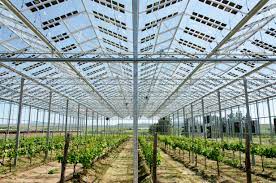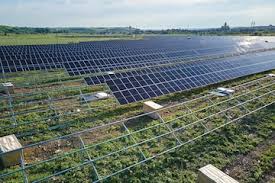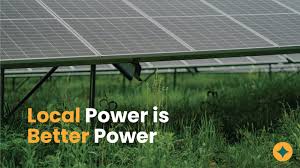GROWING CROPS UNDER SOLAR PANELS NOW SUCCESSFULLY


As countries make the switch to renewable energy, solar power is a major player. All you need is sunlight and land to use for solar panels. It’s that easy. Over the course of a year, a study in “Nature Sustainability” analyzed what is known as “Agrivoltaics”. This is a land-sharing process tat integrates agriculture and solar energy int a symbiotic system; meaning that vegetables are planted in the shade of solar panels.
The agrivoltaics system assisted crops by regulating air temperatures, reducing direct sunlight, and increasing moisture in the air. Panels also protected the crops from intense winds and sunlight. Not only did the panels help the plants, but the plants also increased the efficiency of the solar panels by cooling them via transpiration. In mixed crop solar farms, the skin temperature is 18 degrees cooler than in open fields. This can create a much safer work environment as some farm laborers are at risk of heat stroke and other heat – related dangers.
A team of French scientists lead by Christopne Dupraz were the first to use the term “Agrivoltaic”. It basically means when solar panels and food crops are combined on the same land to maximize the land use. It’s an idea to maximize the land use. It’s an idea which could bring food producing to the next level. Researchers from the University of Arizona have claimed growing crops in the shade of solar panels can lead to two or three times more vegetable and fruit production than conventional agriculture.
The scientists said that their measurements showed how shading from the panels had a positive impact on air temperature, direct sunlight and atmospheric demand for water. The shade provided by the PV panels resulted in cooler daytime and warmer nighttime temperatures than the traditional, open-sky planting system they said. There was also a lower vapor pressure deficit in the agrivoltaics system, meaning there was more moisture in the air.
Solar farming is a field filled with hundreds or maybe thousands of solar panels oriented into the sun. Instead of potatoes, beans or tomatoes planted in the soil, solar panels cover that land, while energy is being produced. It is obvious that traditional farming is a relatively risky business because one is very much dependent on weather conditions. If there is just the right amount of sun, rain and if there no extreme storms, strong winds etc. Thus, not to worry about all these environmental factors and still get income is really uplifting and a bit too good to be true. Therefore, next to power generation, solar farms found another niche “agrivoltaics” – or in other words APV-. It is an amazing idea for a environmentally conscious world, both agribusiness and society.
METHODS
There are three types of agrivoltaics that are being actively researched:
1. solar arrays with space between for crops;
2. stilled solar array above crops; and
3. greenhouse solar array.
All three of these systems have several variables used to maximize solar energy absorbed in both the panels and the crops. The main variable taken into account for agrivoltaic systems is the angle of the solar panels – called the tilt angle. Other variables taken into account for choosing the location of the agrivoltaic system are the crops chosen, height of the panels, solar irradiation in the area and the climate of the area.
TO ENABLE YOU TO RUN SUCH A OPERATION SUCCESSFULLY, YOU WILL NEED ASSISTANCE WITH A PROFESSIONAL BUSINESS PLAN.
CONTACT US NOW FOR PROFESSIONAL/PERSONAL ASSISTANCE AT 084 583 3143 OR money@global.co.za
GROWING CROPS UNDER SOLAR PANELS NOW SUCCESSFULLY Read More »

